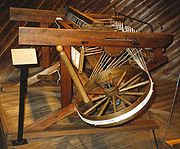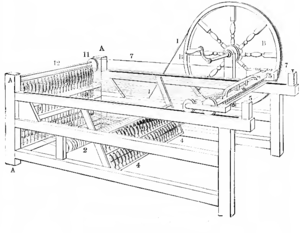
James Hargreaves
Encyclopedia
James Hargreaves was a weaver, carpenter
and an inventor in Lancashire
, England. He is credited with inventing the spinning Jenny
in 1764.
Born at Knuzden Brook near Stanhill, Oswaldtwistle
in Lancashire
, he lived at Blackburn, then a town with a population of about 5,000, known for the production of "Blackburn greys," cloths of linen
Warp
and cotton
weft
. They were usually sent to London
to be printed. The demand for cotton yarn
outstripped supply, and the one-thread spinning wheel
could not keep up.

 The idea for the spinning jenny
The idea for the spinning jenny
is said to have come from the inventor seeing a one-thread wheel overturned upon the floor, when both the wheel and the spindle
continued to revolve. He realised that if a number of spindles were placed upright and side by side, several threads
might be spun at once. The spinning jenny was confined to producing cotton weft, it was unable to produce yarn of sufficient quality for the warp. High quality warp was later supplied by Arkwright's
spinning frame.
The jenny was initially welcomed by the hand spinners, but when the price of yarn fell the mood changed.
Opposition to the machine caused Hargreaves to leave for Nottingham
, where the cotton hosiery
industry
benefited from the increased provision of suitable yarn. Arkwright also ended up in the town, and was even more successful. Hargreaves made jennies for a man called Shipley, and on 12 June 1770, he was granted a patent
, which enabled him to take legal action against the Lancashire manufacturers who had begun using it. Although he failed in this, Hargreaves' business was carried on until his death in 1778, the year before that in which Samuel Crompton
invented the spinning mule
.
Carpenter
A carpenter is a skilled craftsperson who works with timber to construct, install and maintain buildings, furniture, and other objects. The work, known as carpentry, may involve manual labor and work outdoors....
and an inventor in Lancashire
Lancashire
Lancashire is a non-metropolitan county of historic origin in the North West of England. It takes its name from the city of Lancaster, and is sometimes known as the County of Lancaster. Although Lancaster is still considered to be the county town, Lancashire County Council is based in Preston...
, England. He is credited with inventing the spinning Jenny
Spinning jenny
The spinning jenny is a multi-spool spinning frame. It was invented c. 1764 by James Hargreaves in Stanhill, Oswaldtwistle, Lancashire in England. The device reduced the amount of work needed to produce yarn, with a worker able to work eight or more spools at once. This grew to 120 as technology...
in 1764.
Born at Knuzden Brook near Stanhill, Oswaldtwistle
Oswaldtwistle
Oswaldtwistle is a town within the Hyndburn borough of Lancashire, England. It lies on the course of the Leeds and Liverpool Canal, east-southeast of Blackburn and is contiguous to Accrington.-History:...
in Lancashire
Lancashire
Lancashire is a non-metropolitan county of historic origin in the North West of England. It takes its name from the city of Lancaster, and is sometimes known as the County of Lancaster. Although Lancaster is still considered to be the county town, Lancashire County Council is based in Preston...
, he lived at Blackburn, then a town with a population of about 5,000, known for the production of "Blackburn greys," cloths of linen
Linen
Linen is a textile made from the fibers of the flax plant, Linum usitatissimum. Linen is labor-intensive to manufacture, but when it is made into garments, it is valued for its exceptional coolness and freshness in hot weather....
Warp
Warp (weaving)
In weaving cloth, the warp is the set of lengthwise yarns that are held in tension on a frame or loom. The yarn that is inserted over-and-under the warp threads is called the weft, woof, or filler. Each individual warp thread in a fabric is called a warp end or end. Warp means "that which is thrown...
and cotton
Cotton
Cotton is a soft, fluffy staple fiber that grows in a boll, or protective capsule, around the seeds of cotton plants of the genus Gossypium. The fiber is almost pure cellulose. The botanical purpose of cotton fiber is to aid in seed dispersal....
weft
Weft
In weaving, weft or woof is the yarn which is drawn through the warp yarns to create cloth. In North America, it is sometimes referred to as the "fill" or the "filling yarn"....
. They were usually sent to London
London
London is the capital city of :England and the :United Kingdom, the largest metropolitan area in the United Kingdom, and the largest urban zone in the European Union by most measures. Located on the River Thames, London has been a major settlement for two millennia, its history going back to its...
to be printed. The demand for cotton yarn
Yarn
Yarn is a long continuous length of interlocked fibres, suitable for use in the production of textiles, sewing, crocheting, knitting, weaving, embroidery and ropemaking. Thread is a type of yarn intended for sewing by hand or machine. Modern manufactured sewing threads may be finished with wax or...
outstripped supply, and the one-thread spinning wheel
Spinning wheel
A spinning wheel is a device for spinning thread or yarn from natural or synthetic fibers. Spinning wheels appeared in Asia, probably in the 11th century, and very gradually replaced hand spinning with spindle and distaff...
could not keep up.
Spinning jenny


Spinning jenny
The spinning jenny is a multi-spool spinning frame. It was invented c. 1764 by James Hargreaves in Stanhill, Oswaldtwistle, Lancashire in England. The device reduced the amount of work needed to produce yarn, with a worker able to work eight or more spools at once. This grew to 120 as technology...
is said to have come from the inventor seeing a one-thread wheel overturned upon the floor, when both the wheel and the spindle
Spindle (textiles)
A spindle is a wooden spike used for spinning wool, flax, hemp, cotton, and other fibres into thread. It is commonly weighted at either the bottom middle or top, most commonly by a circular or spherical object called a whorl, and may also have a hook, groove or notch, though spindles without...
continued to revolve. He realised that if a number of spindles were placed upright and side by side, several threads
Yarn
Yarn is a long continuous length of interlocked fibres, suitable for use in the production of textiles, sewing, crocheting, knitting, weaving, embroidery and ropemaking. Thread is a type of yarn intended for sewing by hand or machine. Modern manufactured sewing threads may be finished with wax or...
might be spun at once. The spinning jenny was confined to producing cotton weft, it was unable to produce yarn of sufficient quality for the warp. High quality warp was later supplied by Arkwright's
Richard Arkwright
Sir Richard Arkwright , was an Englishman who, although the patents were eventually overturned, is often credited for inventing the spinning frame — later renamed the water frame following the transition to water power. He also patented a carding engine that could convert raw cotton into yarn...
spinning frame.
The jenny was initially welcomed by the hand spinners, but when the price of yarn fell the mood changed.
Opposition to the machine caused Hargreaves to leave for Nottingham
Nottingham
Nottingham is a city and unitary authority in the East Midlands of England. It is located in the ceremonial county of Nottinghamshire and represents one of eight members of the English Core Cities Group...
, where the cotton hosiery
Hosiery
Hosiery, also referred to as legwear, describes garments worn directly on the feet and legs. The term originated as the collective term for products of which a maker or seller is termed a hosier; and those products are also known generically as hose...
industry
Industry
Industry refers to the production of an economic good or service within an economy.-Industrial sectors:There are four key industrial economic sectors: the primary sector, largely raw material extraction industries such as mining and farming; the secondary sector, involving refining, construction,...
benefited from the increased provision of suitable yarn. Arkwright also ended up in the town, and was even more successful. Hargreaves made jennies for a man called Shipley, and on 12 June 1770, he was granted a patent
Patent
A patent is a form of intellectual property. It consists of a set of exclusive rights granted by a sovereign state to an inventor or their assignee for a limited period of time in exchange for the public disclosure of an invention....
, which enabled him to take legal action against the Lancashire manufacturers who had begun using it. Although he failed in this, Hargreaves' business was carried on until his death in 1778, the year before that in which Samuel Crompton
Samuel Crompton
Samuel Crompton was an English inventor and pioneer of the spinning industry.- Early life :Samuel Crompton was born at 10 Firwood Fold, Bolton, Lancashire to George and Betty Crompton . Samuel had two younger sisters...
invented the spinning mule
Spinning mule
The spinning mule was a machine used to spin cotton and other fibres in the mills of Lancashire and elsewhere from the late eighteenth to the early twentieth century. Mules were worked in pairs by a minder, with the help of two boys: the little piecer and the big or side piecer...
.

